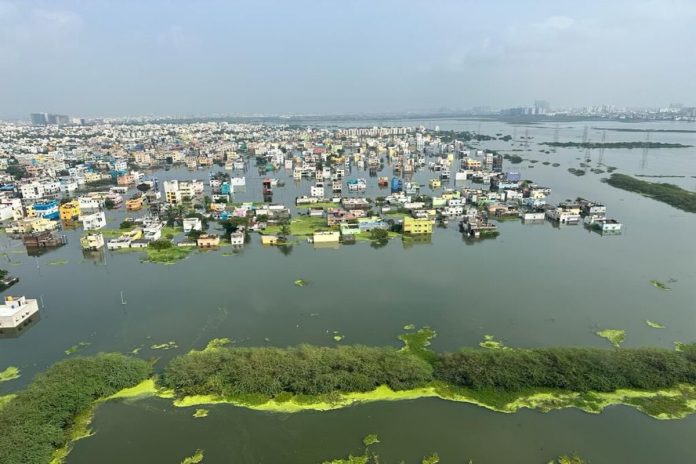The recent havoc wreaked by Cyclone Michaung in Chennai has once again plunged the city into the grip of a natural disaster. Striking on 4 December, the cyclone claimed the lives of at least 20 people and left tens of thousands of residents stranded.
This has prompted a critical examination of the city’s preparedness and resilience in the face of such flash floods. The calamity, exacerbated by the cyclone, not only claimed lives but also submerged entire neighbourhoods, highlighting the city’s vulnerability to climate-related emergencies.
Root Causes And Persistent Challenges: Beyond Cyclonic Impact
Chennai’s susceptibility to floods during the northeast monsoon season has deep historical roots. This season, spanning from October to December, contributes over 40 per cent of Tamil Nadu’s annual rainfall.
The city’s vulnerability to tropical cyclones during this period has led to recurrent floods and widespread distress.
The haunting memories of the December 2015 floods, caused by a combination of extreme weather and reservoir mismanagement, continue to resonate, with the death toll exceeding 200.
Vulnerability Of Chennai For Urban Floods
Chennai is the fourth largest metropolitan area in India, with an estimated population of 10.7 million. The population density is about 26,000 persons per square kilometre, with a high concentration of businesses and industries. It is one of India’s fastest-growing major cities, with an annual economic growth rate of 6 per cent.
While rapid urbanisation has fuelled the local economy, the city is challenged to keep pace with demand for urban services while protecting its fragile environment.
Factors contributing to recurrent flooding include heavy rainfall, insufficient drainage systems, and the incapacity of rivers to manage high discharge levels.
The city’s vulnerability is further exacerbated by rampant violations of building rules, the filling up of water bodies, and construction over channels.
The flat terrain of Chennai compounds the problem, hindering efficient water drainage. However, this predicament is not unique to Chennai but is emblematic of a broader climate vulnerability narrative across Indian cities.
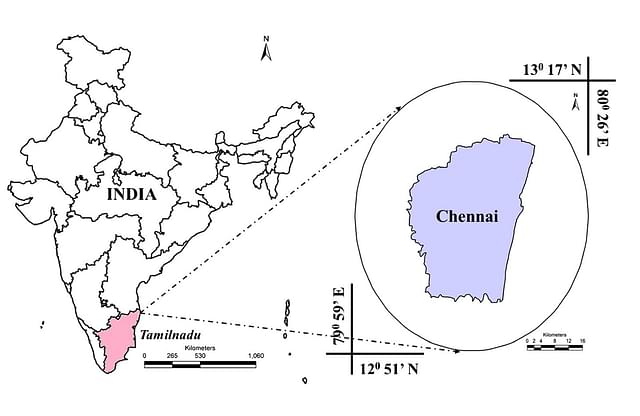
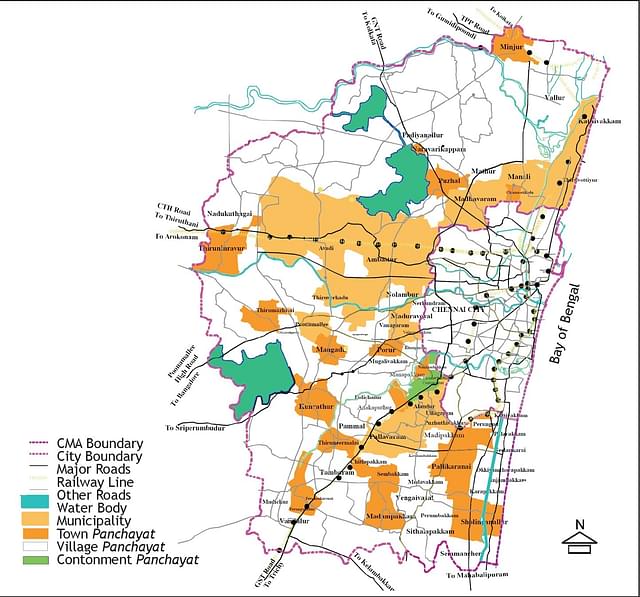
Urbanisation Challenges: The Transformation Of Chennai’s Landscape
Chennai’s jurisdiction expanded in 2011 from 174 km to 426 km. An increasing number of migrant workers have settled in the city and its suburbs, and slums have grown to house 18.9 per cent of the city’s population.
Lack of appropriate planning has allowed urban expansion to alter the natural landscape and land use, shrinking water bodies and expanding impermeable areas.
The water retention capacity of the city’s water bodies is reduced through increased encroachment and unplanned area development, with little consideration of hydrology.
Half of the 19 major water bodies in the city have been encroached upon, severely limiting the available surface water storage potential and its ability to mitigate the impacts of extreme weather events.
Such environmental degradation heightens the risk of widespread damage and loss to the economy and livelihoods from flooding. Industrial enterprises are exposed to worsening risks of severe asset damage and income loss from prolonged inundation, undercutting the area’s ability to attract investment.
Many slum residents live in substandard housing in flood-prone zones. Their average family income is less than half of non-slum households’ income. With limited access to basic services, urban low income households lack the capacity to cope with floods.
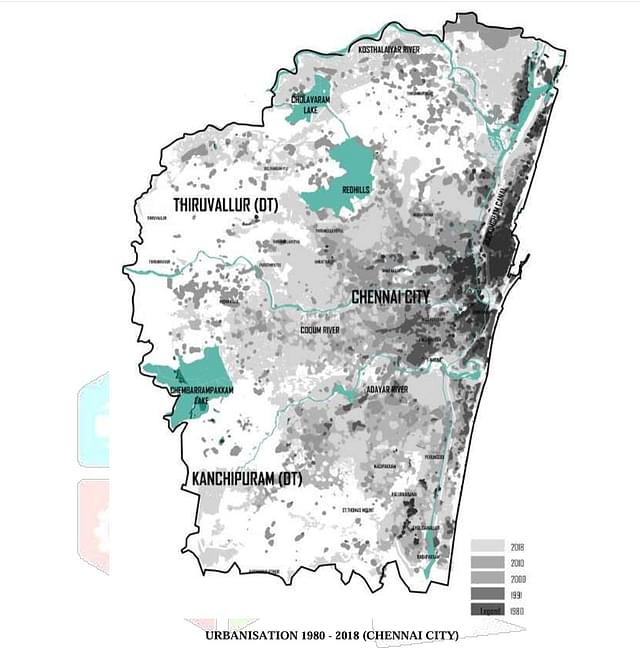
Climate Change Threats: Rising Sea Levels And Coastal Vulnerability
The Climate Change Vulnerability Index of 2021 ranks Chennai the highest among large Indian cities in terms of exposure to climate change-related threats.
Chennai is located on the highly exposed southeast coast of India and is relatively low and flat, with average elevation of 6.7 metre (m) above sea level.
Three major rivers — Adyar, Cooum and Kosasthalaiyar— traverse a coastal bowl, which frequently inundates following even short periods of rain.
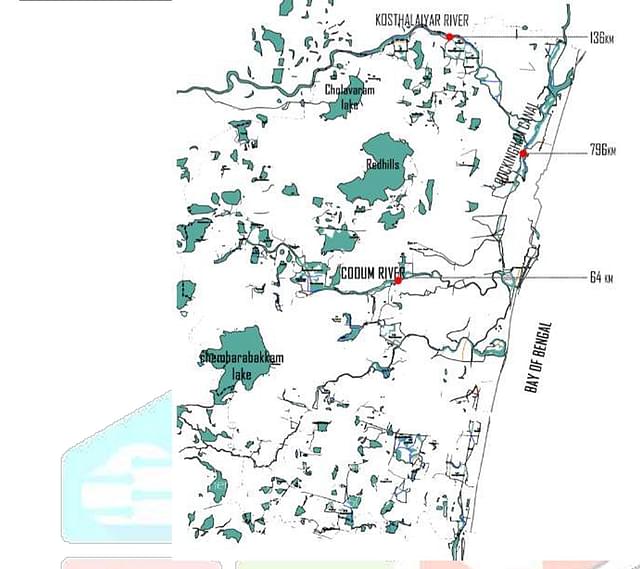
In the past decade, the city has endured more frequent and intense flood and drought extremes. In 2015, Chennai recorded rainfall depth of 348 mm over a 24-hour period, exceeding the 1:100-year annual recurrence interval rainfall depth estimate, following multiple torrential rainfall events in the course of a month. This caused severe flooding, which claimed more than 400 lives.
Research commissioned by the World Bank Group warns of higher sea-level rises for India due to its proximity to the equator. This poses a severe threat to coastal cities, leading to saltwater intrusion, agricultural impact, groundwater degradation, and elevated risks of waterborne diseases.
The IPCC’s 2021 report issues dire warnings, stating that a dozen Indian cities, including Mumbai, Chennai, Kochi and Visakhapatnam, could be submerged by the end of the century.
Metropolises like Kolkata and Mumbai confront threats from sea-level rise, cyclones, and riverine flooding, signaling the urgent need for a nationwide climate resilience strategy.
Lack Of City Planning Accountability
City planning in Chennai lacks public accountability, as evident in the ongoing revision of the third master plan for the Chennai metropolitan area. Flood-related issues and real estate development near water bodies are crucial aspects under consideration.
Experts emphasise the need for a centralised authority, similar to the CMDA, to approve stormwater drainage plans, reflecting the urgency of integrating drainage considerations into the city’s developmental framework.
Reservoir Discharge And Core City Drains
One of the pivotal factors in minimising loss of life during Cyclone Michaung was the early, precautionary discharge of metered water from reservoirs. Evicting encroachments along the banks of rivers like Adyar and Cooum, coupled with the relocation of residents, proved effective.
Recent efforts by the Chennai Corporation in relaying the stormwater drain network facilitated the swift drainage of the core city area, showcasing the importance of infrastructure preparedness.
Governmental Response And Policy Imperatives
Chennai’s flooding has prompted a concerted response from government bodies. The Tamil Nadu Vision 2023 and the Tamil Nadu Sustainable Water Security Mission envision a more resilient future through strategic interventions.
The City Disaster Management Plan emphasises disaster preparedness, and Chennai stands as India’s first city with an advanced flood warning system, CFLOWS, conceptualised post the 2015 floods.
International support, such as that from the World Bank and German development cooperation, reflects collaborative efforts to enhance Chennai’s drainage systems and establish early flood warning mechanisms.
The comprehensive strategy advocated involves structural and non-structural measures, river rejuvenation, watershed development, and a nature-based approach to flood management.
Unraveling The Hydrological Puzzle: The Stormwater Drainage Conundrum
Mark Selvaraj, an expert in urban infrastructure, highlights the changing hydrology of stormwater drains as a critical concern. The design, which once allowed stormwater to reach the sea within an hour, now disposes of urban runoff in 10 to 15 minutes.
Selvaraj stresses the need for a reverse approach, starting from the final disposal point and leading towards residential areas, advocating for the identification of land space for temporary water retention, reports Hindustan Times.
Lessons From Cyclone Michaung: Preparedness And Early Warning
Meteorological forecasts for Cyclone Michaung were accurate, offering a clear window for preparations. While the government demonstrated readiness with disaster rescue teams, health camps, and shelter preparations, the public’s preparedness, especially in flood-prone areas, remains a critical aspect for future considerations.
The ability to act on the forecast played a crucial role in mitigating the impact of the cyclone.
To build resilience against the unpredictable impacts of climate change, a holistic flood management strategy is essential. This encompasses enforcing building codes, anticipating climate-related disasters in urban planning, coastal embankments, and strict coastal regulation zone codes to counter sea-level rise.
Watershed management and adopting ‘sponge city’ concepts are critical for mitigating flood risks.
Road Ahead: Comprehensive Strategy For Flood Management
The effective and long lasting strategy not only involves structural and non-structural measures but also some important measures like river rejuvenation, watershed development, land use planning, tree horticulture along the banks of the rivers, creation of lakes and wet lands in urban areas for flood management and water security.
Flood risk management should be integrated with urban planning and management. Constructing and maintaining an extensive network of stormwater drains that can handle the volume of water during heavy rainfall events. This includes both macro and micro drains.
Flood management measures can have multiple co-benefits from nature-based solution such as increased amenity value and biodiversity improved by the greening of urban spaces and water body rejuvenation.
Adequate operation and maintenance (O&M) of flood management assets is key to sustainable management.
Integrated urban management approach in which urban stormwater management is supported by the management of other urban utilities, such as sewage collection and treatment, and solid waste collection and disposal.
Educating residents about the importance of proper waste disposal, responsible water management practices, and flood preparedness, as well as encouraging community participation in flood mitigation efforts.
In conclusion, Chennai’s recent floods beckon a call to action — a call for cities capable of withstanding the severe impacts of a changing climate. As India’s urban centres burgeon, urgency surges for resilient infrastructure, sustainable planning, and a steadfast commitment to mitigating the effects of climate-induced disasters.
The road ahead demands continued evaluation, adaptation, and collaboration with relevant stakeholders will be crucial in enhancing flood resilience and ensuring long-term success in mitigating urban floods.


